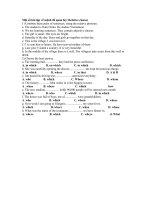RELATIVE CLAUSE # 3
Bạn đang xem bản rút gọn của tài liệu. Xem và tải ngay bản đầy đủ của tài liệu tại đây (67.2 KB, 2 trang )
RELATIVE CLAUSE(part 3)
This time we will continue with " Non-Defining R.C"
B/Non-Defining R.C :
1/ A non-defining r.c contains extra information :
- In writing it is seperated by comma ,and in speech , if use " at all", is usually indicated by
intonation .
Ex :
A train , which was already an hour late,broke down again .
-Non-defining r.c are placed after nouns which are definitely "already" .They do not
therefore define the noun, but merely add something to it by giving some more information
about it .
-Unlike Defining r.c , they are not essential in the sentence and can be omitted without
causing confusion .The pronoun can never be omitted in a non-defining clause .
NoTice that we put a comma between a noun and a non-defining clause and another
comma at the end of this clause if it is not also at the end of the sentence .
2/Relative pronouns used in non-defining r.c :
---For Persons :
----Subject :Who
----Object :whom/ who
----Possesive :Whose
a/ Subject :who-We use "who" as the subject of the clause
Ex:
Peter ,who had been driving all day, suggested stopping at the next turn .
Notice that :
Clauses such as these ,which come immediately after the subject of the main verb . In
spoken English we would be more likely to say :
Peter had been driving all day so he suggested stopping
at the next turn.
--Clauses following "a preposition +Noun " are also common .
Ex:
I passed the letter to Peter ,who was sitting next to me .
b/Object :who/whom
-We used "who/whom " as the subject of the main clause although "whom" is more formal
and rarely used in spoken English .The pronoun can't be omitted .
Ex :
Peter , who/whom I admire , is going to visit the university next week .
--But non-defining clauses , coming later in the sentence , after the object of the main verb
or after a preposition+noun , are common in conversation .
Ex :
She introduced me to her husband ,whom i hadn't met before .
c/ Object of a preposition
-The preposition is normally placed before "whom" and the pronoun can't be omitted .
Ex:
Mr Richard , for whom i was working , was vey generous.
--It is however possible to move the preposition to the end of the clause . This is commonly
done in conversation and "who" then finally take the place of " whom"
Ex:
Mr Richard , who i was working for , was generous.
--If the clause contains the expression of time or place , this will remain at the end.
Ex:
John , with whom i played tennis last week, was fatter than me .
John , who /whom i played tennis with last week , was fatter than me .
d/Possesive:whose
Ex :Ann, whose children are at school all day , is trying to get a job .
Note:"All , both , most, few , several, some "+of + whom/ which<--------This form can be
both used for people and things.
-When we want to add information about the whole or the part of a particular number of
things or people , we can use the non-defining r.c with " of which/of whom" after words
such as :"all,both,each,many,most,neither,none,part,som e , (a number ne ,two.
thee,...,the first ,the second ,.... ,a half , a third ,...)and superlatives ( the best , the
biggest,....)
Ex:
Her sons , both of whom study abroad , ring her up every week.
The busses, most of which are already full, were surrounded by an angry crowd.









